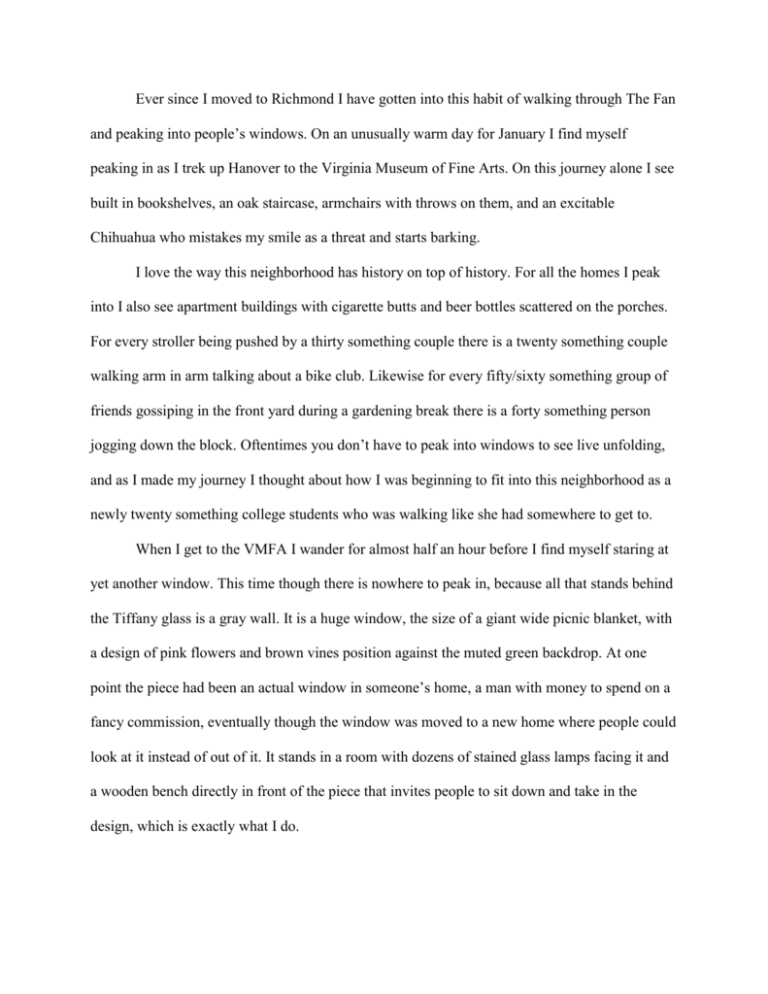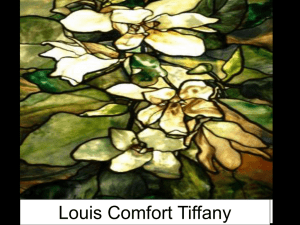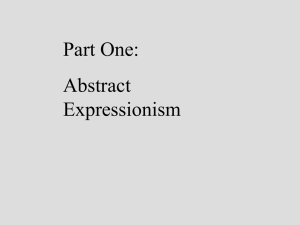ADV Writing Flash Piece 1
advertisement

Ever since I moved to Richmond I have gotten into this habit of walking through The Fan and peaking into people’s windows. On an unusually warm day for January I find myself peaking in as I trek up Hanover to the Virginia Museum of Fine Arts. On this journey alone I see built in bookshelves, an oak staircase, armchairs with throws on them, and an excitable Chihuahua who mistakes my smile as a threat and starts barking. I love the way this neighborhood has history on top of history. For all the homes I peak into I also see apartment buildings with cigarette butts and beer bottles scattered on the porches. For every stroller being pushed by a thirty something couple there is a twenty something couple walking arm in arm talking about a bike club. Likewise for every fifty/sixty something group of friends gossiping in the front yard during a gardening break there is a forty something person jogging down the block. Oftentimes you don’t have to peak into windows to see live unfolding, and as I made my journey I thought about how I was beginning to fit into this neighborhood as a newly twenty something college students who was walking like she had somewhere to get to. When I get to the VMFA I wander for almost half an hour before I find myself staring at yet another window. This time though there is nowhere to peak in, because all that stands behind the Tiffany glass is a gray wall. It is a huge window, the size of a giant wide picnic blanket, with a design of pink flowers and brown vines position against the muted green backdrop. At one point the piece had been an actual window in someone’s home, a man with money to spend on a fancy commission, eventually though the window was moved to a new home where people could look at it instead of out of it. It stands in a room with dozens of stained glass lamps facing it and a wooden bench directly in front of the piece that invites people to sit down and take in the design, which is exactly what I do. There is a Regina Spektor song called All the Rowboats that describes how art galleries might feel from the art pieces’ perspective. In the song Spektor cries out to the musical instruments on display that no longer get to be played. She describes the art as “masterpieces serving maximum sentences” and the galleries and museums as “public mausoleums; the living dead fill every room”. I think about Spektor’s words as I stare at the window. It’s so beautiful it feels out of place here at the museum. I find myself thinking that it belongs in someone’s home where it is not being gawked at, but appreciated and understood for what it is. I think that I feel this way, because it used to be a window, and not like the Frank Lloyd Wright ones down the hall that were made by a studied architect who was an artist in his own right, it was just made to be a window not to have a gallery future . It wasn’t made to be remembered the way it’s going to be; “Tiffany Glass Window” glanced at by many, stared at by some. We can enjoy the window in the gallery, but it looks uncomfortable like the violins in glass cases Spektor describes, like the jewelry no one is ever going to wear again on display one room over. This all makes me think about John Logan’s play Red which is about the artist Mark Rothko and the inner conflict the artist goes through painting murals for an upscale restaurant. The play is based on Rothko’s real life commission from the Four Seasons. Ultimately Rothko turns the deal down and refuses to give the restaurant his paintings. In one of the play’s final monologues Rothko explains to his assistant how he felt after visiting the restaurant, he concludes “And in that place-there-will live my paintings for all time. I wonder…do you think they’ll ever forgive me?” It is an artist’s interpretation of another artist and I think that is what makes those closing lines such a strong moment in the play. This idea that Rothko is so attached to his work that he worries about the home these paintings are going to; it reflects how Logan appears to feel about releasing his version of Rothko into a public audience. Art is a personal thing, particularly to the person who creates it. It is easy to look at a Rothko painting and critique it as being too easy or simplistic to be art, but Logan’s play shows how it is the artist’s passion behind his work that makes the paintings so valuable. The Tiffany glass window is not simplistic, it was not easy to make, but it was made for somewhere outside the world of an art museum so to me it looks out of place. This window once had a life where it was looked out of and looked into. Perhaps an anxious dog attempted to look out of the window at one point in its history, but was thwarted by its thick glass. People walked by the window on the street on their way to art museums and glanced at it, stopped to look at it. Maybe they wished it were in their own home, maybe they thought that it was too excessive to be anywhere but the home it inhabited. These people were couples pushing strollers, people taking breaks from gardening, a college student walking with a purpose. I feel a strange empathy for the window and I wonder if it will ever find its way to another place. If it will ever get to be an actual window again. At the same time though, if this window had never left a house environment I would not be staring at it right now. I would not be allowed the chance to enjoy how beautiful this piece of art truly is. It is a piece of art. The design is stunning and somehow plain, but also unique. I have only looked at it for fifteen minutes at most and I am already thinking of Regina Spektor lyrics and one of my favorite plays. It is rare for me to feel this at home in a gallery. So maybe the window isn’t completely out of place, because it is in a quiet room with a warm light sitting behind it to illuminate the patterns. Maybe galleries need more art that at one point functioned as something outside of being art. Perhaps that is why there is a bench in front of the window with artificial light and not in the room with eighteen early French renaissance paintings. It is painful for me as an artist to imagine that another artist’s work is not in the place they wanted it. What if Rothko’s paintings had wound up at a restaurant? What if that violin never gets played again? At the same time there is a point in the creative process where you must let go of this control if you want the art to be seen or heard. The Tiffany window is not broken yet, it still has some good years ahead of it, and not all of them are going to be spent at the VMFA. I know I will have to leave soon, but already know that the walk home will have less window peaking and more inward searching of myself. My personal windows. Someone walks by as I sit on the bench journaling down initial thoughts. They glance at the glass like it’s something they’ve seen before. “That’s beautiful.” They say and then walk on.











